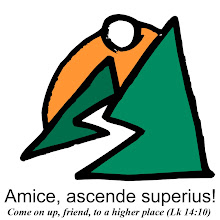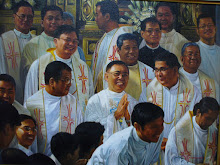
MARIA, MATER SPEI, STELLA MARIS
N.B. I am posting the first part of a talk I gave to a group of monastic religious and priests on February 7, 2009. The second part will follow soon.
1st Part:
WHAT IS GOING ON?
I would like to take my cue for this talk from what tomorrow’s liturgy (5th Sunday in Ordinary Time, Year B) would have us reflect on a whole lot. At the risk of being facetious and simplistic, I would like to suggest that our recollection can be helped in no small measure by being attuned to what liturgy offers us as cause for genuine celebration. We know that liturgy is basically a celebration in sign, song, symbol, word and gesture of THE event that mattered most for us, and that is the event called salvation.
Salvation … a word that we bandy about so freely, a word that has, over the recent past, lost both its power and its punch, its push and pull, and its promise, on the one hand, and its call to endless possibilities, on the other. If we go by what economists tell us, what with their sour and dour prognostications, then all our financial power has suddenly vanished like the thin dew in the early morning sun of economic meltdown. In what Christopher Ruddy (2006) refers to as a growing phenomenon of
“distance and distrust” that seem to characterize so many of our institutions all over the shrinking globalized world, our concept of stability, solidity, and surety have all but vanished with Maddoff’s billions of dollars that evaporated into the thin air of hopelessness, now hovering all over the world, now reeling under the onslaught of receding prices, receding productivity, receding demand, and receding trust for one another. Why, even the glaciers that took millions of years for nature to build, are now receding themselves, and cracking dangerously, sending alarum bells of concern to environmentalists and ethicists alike. The world is busy trying to breed pandas and polar bears, but the same world is busy pandering to its desires for the more, the better, the higher in every way, thus effectively destroying the poor bears’ natural habitat. As we speak of salvation, more than just polar bears and panda bears are in danger of perdition – the opposite of salvation!
Salvation is now most difficult to define, digest, and much less, deliver to people. Where surety and certitude have gone out the window, what enters in through the wide, gaping door of disappointment is the shake-up ultimately of our spiritual moorings, once solid and stolid in our collective psyche, propped up by a premodern society that reveled in. and was at home with, the uncertainty of the seasons, the unpredictability of the weather, the total mystery attached to most everything people do, from planting to harvesting, to drying their produce in the sun, all the way up to storing them and taking them to market, oftentimes, falling victim to the rise and fall of prices subject to the mysterious law of supply and demand.
Everything was unpredictable, and what does one do to save oneself from losing it all and becoming a nervous wreck? We charge it all to faith. We dump it all on hope, and we refuse to even think that all of it happens as the workings of an unloving God, who is not concerned a wee bit about the welfare of His people. We still love Him. We still believe in him. Believing and belonging were all part of the package of our Christian faith. And when people believed and belonged, no matter what the trials might have been, we were assured of salvation. We rested assured that, despite all, God is close to the broken hearted.
Or is He?
The books I have recently come across with that speak about the priesthood, are somewhat, to put it mildly, a little schizophrenic (pardon the term). One book of Rosetti (2005) is entitled “The Joy of Priesthood.” Without in any way intending to sound like I am against the grain, I do give him credit for making much of the incontrovertible statistical data that say over 90 % per cent of clergy in America report themselves as “happy.” And then he devotes 13 chapters to giving tips on how this data can become truly a reality for all priests. But some titles seem to go to the opposite pole, like Ruddy’s (2006) “Tested in Every Way.” Dominic Grassi’s (2003) homely, engaging, and expansive style, focuses on concrete events in his many years of service as a priest, more often than not, characterized by intense moments of genuine inner joy and deep personal satisfaction, peppered though his life was, with things that don’t go anywhere near “joyful” and “satisfactory.” The books on priesthood written after what Fr. Richard Neuhaus referred to wryly as
“the long Lent of 2002” immediately following the sexual abuse crisis in the United States, appeared to me to see-saw between being utter “praise releases” and a courageous facing up to the real issues at stake.
My approach to today’s reflection is more like in the persuasion of Timothy Radcliffe (2005), the former Master General of the Order of Preachers, who wrote a book, with a big, bold title emblazoned next to his awe-filled, and faith-filled – if, plaintive – countenance:
“What is the Point of Being a Christian?”I don’t pretend nor intend to make a summary of what he writes so eruditely in his valuable theological and literary gem. I would simply like to take my cue for the rest of my reflection today with you from that question (THE TITLE) which to my mind sounds as poignant as it is perspicacious and piercing …
What is the point of being a Christian when all of Europe is getting to become what the late atheist Italian writer Orianna Fallaci many years ago prophetically referred to as “Eurabia?” What is the point of being a Christian when we are surrounded, if not inundated, by and with, a vast ocean of humanity and society filled with what E. Robinson (2004) refers to as
“contours of hopelessness?” What is the point of being a Christian when the so-called “media moment” has, for decades, especially in Philippine context, effectively taken the place of both school and church in shaping values and influencing societal morals and standards of what is legitimate and illegitimate behavior? What is the point of being a Christian when, despite the painstaking – and, I presume – objective reports by the World Bank on shady deals done by government people, all their conclusions and warnings can be swept away with the wave of a hand at a hasty, emotion-filled, and drama-rich telenovela-like congressional investigation?
What is the point? I would like to raise the issue that as Christian believers and as priests and religious, there is something eminently valid in our question today.
I would like to suggest that this question stands at the core of our capacity to engage in the act of meaning-making that is the hallmark of our being pastors, educators, and educational leaders. Our ability to articulate an answer to this basic question stands at the basis of all we do, all we are, and all we stand for as priests, as monastic and active religious, and as pastoral leaders in a nation that is fast drifting into a collective state of semi paralysis, and, if we let go of our guard, seems to be bent on becoming, not only among the most corrupt nations, but also a budding narco-state, run by a coterie of so-called public servants whose sole and only preoccupation is to safeguard their hold on power, privilege, prestige and position till the next sham elections come around.
But it is no rocket science that before we can attempt at giving an answer to this question, we first need to see exactly what the context in which the question is put forward. This first part of my talk, therefore, focuses on the “what” … What is going on? What exactly are we referring to? I believe that it is only when we understand what is going on, can we rightly and legitimately ask the question we started out with? What, then, is the point in being what we are, and what is the point in doing what we have been doing, and will continue to be doing down the road?
Let me begin by borrowing rather heavily from Ruddy (2006, pp. 18ss). He reports on the study done by the Canadian historian Scott Appleby who suggests that there are three challenges and three tasks facing the Church and its priests. The first is what Appleby calls the
“challenge of skepticism.” At its core is the raging doubt about reason’s ability to come to reliable conclusions about the ultimate nature of reality. Basically a reaction to the Enlightenment, which enshrined reason as the ultimate answer to the riddle of existence, this trend of skepticism is behind the postmodern crisis of reason and the rise of moral relativism. Reason has been applied to every perceived or real problem in the past. For many it took the form of technologism, that reduced every problem and its solution to finding the right technological tool to banish it. But it did not take the world long to know that as Peter Senge said,
“the solution of today is the problem of tomorrow” (1990). Plastics poised decades ago as the perfect solution to the problem of packaging. Now, the world does not know what to do with the plastic bags that are produced by the world to the whopping tune of 3,000,000 a minute, every single one of them needing about a thousand years to degrade!
The second challenge is the
“erosion of biblical and theological literacy.” A certain “hermeneutic of suspicion,” is applied before authority and their tendency to weave grand narratives like “progress” or “redemption.” Postmodern people are averse to metanarratives, and any grand institution espousing such far-ranging and grand designs are met with indifference at best, and hostility, at worst. We do not have to go too far to see its effects in our culture. The western solar new year and the Chinese lunar new year, were both met with a bang and an unprecedented flair in Philippine setting of late. Hordes of “experts” in
feng shui flew in from Hong Kong, paid for by the two giant warring media networks. In the run-up towards the celebration of Chinese New Year, the Filipino people were barraged with everything Chinese, like as if, all of a sudden, we were like Vietnam, which happens to have been under Chinese hegemony for 1,000 years! The receding images of biblical figures that used to dominate our collective consciousness have now been effectively replaced by crystals, by aromatic candles, all sorts of aromatherapy techniques and products, and a whole lot of hullabaloo attached to animal figures like oxen, monkeys, dogs, goats and others in the Chinese horoscope.
But the same biblical and theological illiteracy offers what seem to be conflicting signs as our people navigate through the maze of uncertainty, lack of surety, and a whole lot of confusion in the arena of economics, politics, and other arenas. Whilst the theological foundation of our societal lives continues to recede, hordes of fanatic “devotees” to the Black Nazarene, and the Santo Nino increase almost exponentially every year. We happen to be the only country where the original image of the Christ Child has assumed a rapid evolution and what used to look like an exact replica of what is found in Prague, in Spain, or elsewhere, has become a cute, chubby little boy, dressed in all imaginable form, guise, and appearance.
What is going on exactly?
The first and the second challenges coalesce and combine to produce a third challenge:
“a fractious pluralism that undermines the possibility of a genuinely diverse but unified moral and religious community.” Whilst diversity and pluralism, per se, are not bad, the trend seems to be pointing toward unhealthy new forms of tribalism in which one group’s identity is defined against the identity of the other group. Healthy self-differentiation is replaced by unhealthy opposition. The misplaced passion that we see in certain fundamentalist groups, whether Christian or otherwise, and their rabid dedication to their groups’ mindset are a frightening case in point. The currently increasing phenomenon of Catholics identifying with opposing sides of the religious spectrum that pits conservatives against progressives is another case in point.
I have been a priest for 26 years. Once, invited by friends in a parish in Northern VA, to celebrate my 24th year as a priest, I was getting ready for Mass in the sacristy. Two newly ordained priests attached to the parish obviously on one side of this spectrum literally ordered me to wear my stole inside the chasuble. Whilst personally I have always preferred to wear the stole inside the chasuble, that day, the one I brought that fitted me was the external one that we are more used to here in the Philippines. I didn’t take offense, but I felt a little turned off by what appears to be the air of intolerance for something that didn’t really matter a whole lot in terms of theological validity and liceity. Such cockiness and rabid attachment to one’s position is a clear case that illustrates the tendency to
“shore up religious authority and truth” and facetious
“appeals to inerrancy and infallibility” and the
“demonization of one’s opponents as insufficiently pure or orthodox” (cf. Ruddy, pp.18ss).
I have been a teacher for 32 years. I began as an emaciated newly professed brother teaching catechism and a little of English and a smattering of other subjects. I taught High School and College, and for the past 17 years, post college, teaching theology students Moral Theology and Pastoral Psychology. Every year, I see additional challenges. Every year, I pine for times past when students were more ready to be students and more prepared to do normal student routines like writing scientific papers, and the like. Now, aside from the need to go back to English 101, one simply feels like making an uphill climb all the time, trying, first and foremost, to establish a common language in order to engage in meaningful discourse.
This is, to borrow the phraseology of Robinson (2004), the
“landscape of our lives.” This terrain is characterized by what she calls
“contours of hopelessness.” The elements that make up such contours are basically the same challenges that Appleby speaks about: the compression of time, the contraction and at the same time, expansion of space, the cultural landscape produced by the first two, and the phenomenon of the
“media moment” as the catalyzing and hastening principle behind the rapidly changing signs of the times.
In plain language, our hope and the ability to set our sights on things that are above, are effectively compromised. Hope has become replaced by a shallow rationality, cynicism, and downright despair – the thought and attitude that there is not much we can do about it. Let me put it like no one else can better do. I quote Robinson:
“Time, space, and culture, as accelerated by the media moment, converge to burden and weigh us down like leg irons, dragging us in the direction of hopelessness. It seems that God is not solving the problems of this world, and our human attempts to do so, time and again, prove to be futile” (2004, p. 108).
I couldn’t find better words to wrap up this first part of my talk, other than quoting PCP-II, itself paraphrasing good old Charles Dickens:
“We live in the worst of times. We live in the best of times. But only if crisis is made to become kairos. And we seize the grace of the moment and respond to its challenge. As we should, always, in faith.” (#1)





